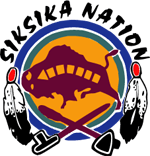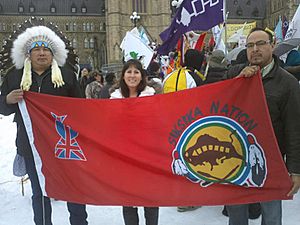Siksika Nation facts for kids
 |
|
| People | Blackfoot |
|---|---|
| Treaty | Treaty 7 |
| Headquarters | Siksika |
| Province | Alberta |
| Land | |
| Reserve(s) | |
| Land area | 710.875 km2 |
| Population (2020) | |
| On reserve | 4120 |
| On other land | 2 |
| Off reserve | 3412 |
| Total population | 7534 |
| Government | |
| Chief | Ouray Crowfoot |
| Tribal Council | |
| Samuel Crowfoot, Ruben Breaker, Ike Solway, Kent Ayoungman, Carlin Black Rabbit, Kendall Panther Bone, Leon Crane Bear, Susan Solway, Jenny Goodin, and Tracy McHugh. | |
| Website | |
| siksikanation.com | |
The Siksika Nation (Blackfoot: Siksiká) is a First Nation located in southern Alberta, Canada. The name Siksiká comes from the Blackfoot words sik (black) and iká (foot). There is a connector s between these two words. The plural form of Siksiká is Siksikáwa.
The Siksikáwa are the most northern group of the Niitsítapi (Original People). All Niitsítapi speak different forms of Blackfoot, which is an Algonquian language. When European explorers first came west, they likely met the Siksiká people first.
The four Niitsítapi nations that form the Blackfoot Confederacy are:
- the Siksiká
- the Káínaa (Kainai or Blood)
- the Aapátohsipikáni (Northern Peigan)
- the Aamsskáápipikani (South Peigan or Montana Blackfoot)
As of 2009, the Siksika Nation had about 6,000 people.
Contents
Siksika Nation's Economy and Community Growth
Siksika Resource Development Limited
The Siksika Resource Development Limited (SRDL) is the Siksika Nation's main economic group. It was started in 1997. The SRDL manages many different businesses and properties for the Nation.
On July 16, 2022, the SRDL worked with volunteers from the 'Calgary Tree Planting Team'. They planted 300 Saskatoon berry trees near the "Siksika Business Plaza". This project helps the Nation get more food and supports its economic growth.
Siksika Family Services and Children's Village
The Siksika Family Services received money from the government's 'Rapid Housing Initiative'. This money will help build a special community called "Children's Village". This community will have 24 homes for families and young people who need support. It will help them reconnect with their culture.
Where is the Siksika Nation Located?
The Siksika Nation reserve, Siksika 146, is about 95 km (59 mi) east of Calgary. It is also about 3 km (1.9 mi) south of the Trans Canada Highway (Highway 1). The main offices and businesses are next to the community of Gleichen.
The Siksika Nation has the second largest land area among First Nations in Canada. The traditional territory of the Blackfoot Confederacy has clear boundaries. To the north, it reaches the North Saskatchewan River. To the west, it goes to the Rocky Mountains. In the east, it extends to where the North and South Saskatchewan Rivers meet. To the south, it reaches the Yellowstone River.
Siksika Nation Land Claims

The Siksika Nation has been in a long disagreement with the Government of Canada. This dispute is about events that happened in 1910. At that time, the government wanted to take about 46,621.4 hectares (115,204 acres) of land from the Siksika Indian Reserve. They planned to sell this land to new settlers.
This land deal also included transferring 5,067.6 hectares (12,522 acres) of reserve land to the Canadian Pacific Railway. This was for building the Bassano Dam. The Siksika people were not fully told about this part of the deal. They lost the right to use the surface of this land. The Nation says this transfer was done illegally. In 1980, the government admitted there was no proof that Canadian Pacific had legally gained rights to the land for the dam.
The Siksika Nation started talking with the Canadian government to settle this land claim. In 1991, the Siksika Nation signed an agreement for $4.9 million. This was to make up for mineral rights lost because of the dam's construction. In 2010, the Nation finally reached an agreement with the governments of Canada and Alberta. This agreement settled the land claims. The Nation would receive $50 million and new water rights. This money would be put into a trust. It would help the Nation with things like education and welfare.
1910 Global Settlement Agreement
The process of settling these land claims began in 1960. This was under the leadership of Siksika Chief Clarence McHugh. He became chief in 1959. Chief McHugh once said, "They told us they would give us a bag of money which would never empty, but somehow, that bag developed a great big hole." He was talking about Frank Oliver, a government minister from the past.
Frank Oliver was known for taking large amounts of land from First Nations across Canada. He would advise First Nations to give up their treaty land. In return, he often promised things that were not kept. Sometimes, he would even deny basic needs like food. He promised the Siksika: "It might be better to sell what they do not use for a big bag of money, which could give them money for ever and ever!" Chief McHugh described the land loss as, "They cut our reserve up like a Christmas turkey and wasted our money." A reporter described the Siksika homes as "ramshackle, uninsulated houses without foundations, with cracks and broken windows, patched up with rags and cardboard." These houses were built after the 1912 land sale.
In December 2021, Siksika members voted on the '1910 Global Settlement Agreement'. A large majority, 77% of voters, approved it. This agreement is a big solution to many land claims and related issues. It includes $1.3 billion in compensation. It also gives the Nation the right to buy 115,000 acres from willing sellers.
On June 2, 2022, a signing ceremony took place at the Blackfoot Crossing Historical Park. The Federal government and the Siksika Nation officially signed the '1910 Global Settlement Agreement'. This marked the end of 60 years of talks. It helps correct the illegal taking of 115,000 acres (465.4 square kilometers) of Siksika land. This land was important for farming, ceremonies, and minerals. The agreement also covers mineral royalties from 1910.
The money from the settlement will be used in several ways. Each band member will receive $20,000. Important priorities include setting up a police force, supporting education, improving infrastructure, and helping with residential school searches.
Notable People from Siksika Nation
- Ouray Crowfoot: Current Chief of the Siksika Nation (around 2019). He signed the '1910 Global Settlement Agreement'.
- Crowfoot: A famous chief of the Siksika Nation (around 1885). He was a signer of Treaty 7.
- Aatsista-Mahkan (Running Rabbit): Featured in a photo by Edward S. Curtis.
- Robin Big Snake: A former professional hockey player. He played for the Muskegon Lumberjacks in the 2009-10 International Hockey League season.
- Armond Duck Chief: A country singer and songwriter.
- Gerald McMaster: An artist, curator, and author.
- Adrian Stimson: An artist who works in many different fields. He won the Governor's General award in visual and media arts in 2018.
- Maggie Black Kettle: A storyteller, educator, dancer, actress, and community leader.
Siksika Nation Leadership
Chief and Council Members
Ouray Crowfoot, Samuel Crowfoot, Reuben Breaker, Ike Solway, Owen Crane Bear, Candace Backfat, Carlin Black Rabbit, Kendall Panther Bone, Hector Winnipeg, Strater Crowfoot, Marsha Wolf Collar, and Tracy McHugh.
Chief and Council Staff
Mariah Little Chief, Sharon Brass, Erica Sitting Eagle, and Allison Duck Chief.
Tribal Administration
Richard Sparvier, Van Le, Tom Many Heads, and Hossam Yaqoub.
Images for kids
-
Sahpo Muxika, also known as Crowfoot, Head Chief of the Siksika, c. 1885
-
Aatsista-Mahkan, circa 1900, by Edward S. Curtis
-
Gerald McMaster, 2009





